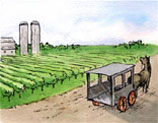
 Only in recent years has Lancaster Valley returned to the wine scene, after a 100-year sabbatical. The first vineyards were planted here in 1790, and flourished well into the mid-1800s. Plagued by disease and some unusually cold winters, the industry was wiped out and vine growing did not resume until the 1960s. Located in southeastern Pennsylvania, the Lancaster Valley is over 30 miles long and 12 miles wide, encompassing over 225,000 acres, 400 of which are under vine. Home to less than 10 wineries, this appellation is featured in many of the state’s winery trails. More accurately described as the "Lancaster Depression", the boundaries of this appellation are defined by its highly-elevated surroundings. Similar to other valleys in the state, the Lancanster Depression rests on an easily-eroding, very well drained and deep limestone bed. Lancaster Valley is rich and fertile, making it the wealthiest agricultural community in the entire state. While grapes are not the premier crop, the fruit is rich and ripe, resulting in juicy Cabernets, Chardonnays and Rieslings.
Only in recent years has Lancaster Valley returned to the wine scene, after a 100-year sabbatical. The first vineyards were planted here in 1790, and flourished well into the mid-1800s. Plagued by disease and some unusually cold winters, the industry was wiped out and vine growing did not resume until the 1960s. Located in southeastern Pennsylvania, the Lancaster Valley is over 30 miles long and 12 miles wide, encompassing over 225,000 acres, 400 of which are under vine. Home to less than 10 wineries, this appellation is featured in many of the state’s winery trails. More accurately described as the "Lancaster Depression", the boundaries of this appellation are defined by its highly-elevated surroundings. Similar to other valleys in the state, the Lancanster Depression rests on an easily-eroding, very well drained and deep limestone bed. Lancaster Valley is rich and fertile, making it the wealthiest agricultural community in the entire state. While grapes are not the premier crop, the fruit is rich and ripe, resulting in juicy Cabernets, Chardonnays and Rieslings.
|
|
Current Feature
In the southern Blue Ridge Mountains of North Carolina and Georgia vineyards are small and few, yet the establishment of the Upper Hiwassee Highlands could bring much more.
[>] continue
Related Features
Alive & Well here

Seyval Blanc:
Sure, it’s true that your lean body and restrained mineral nature have been compared to Chablis, but
[>] continue
